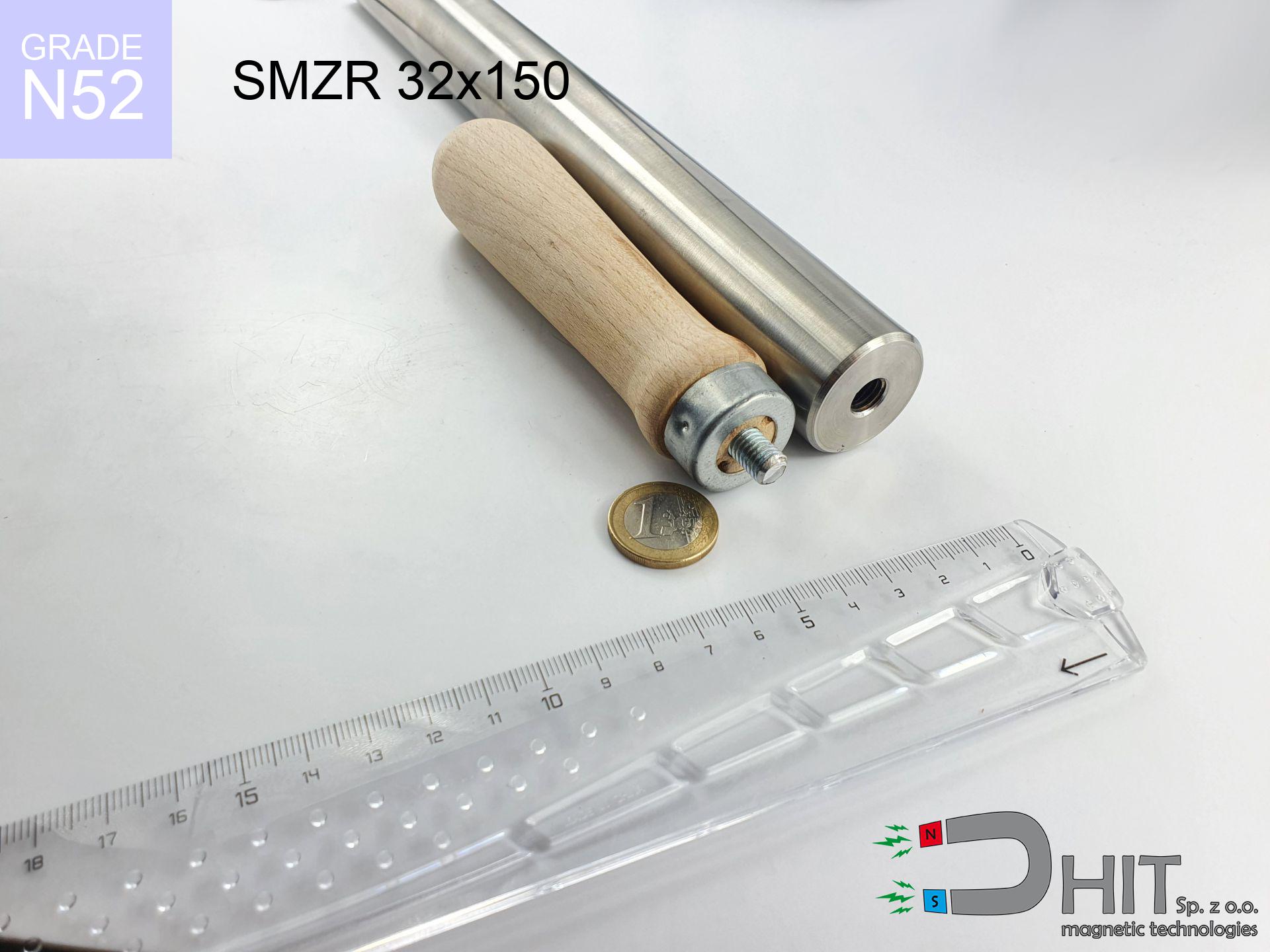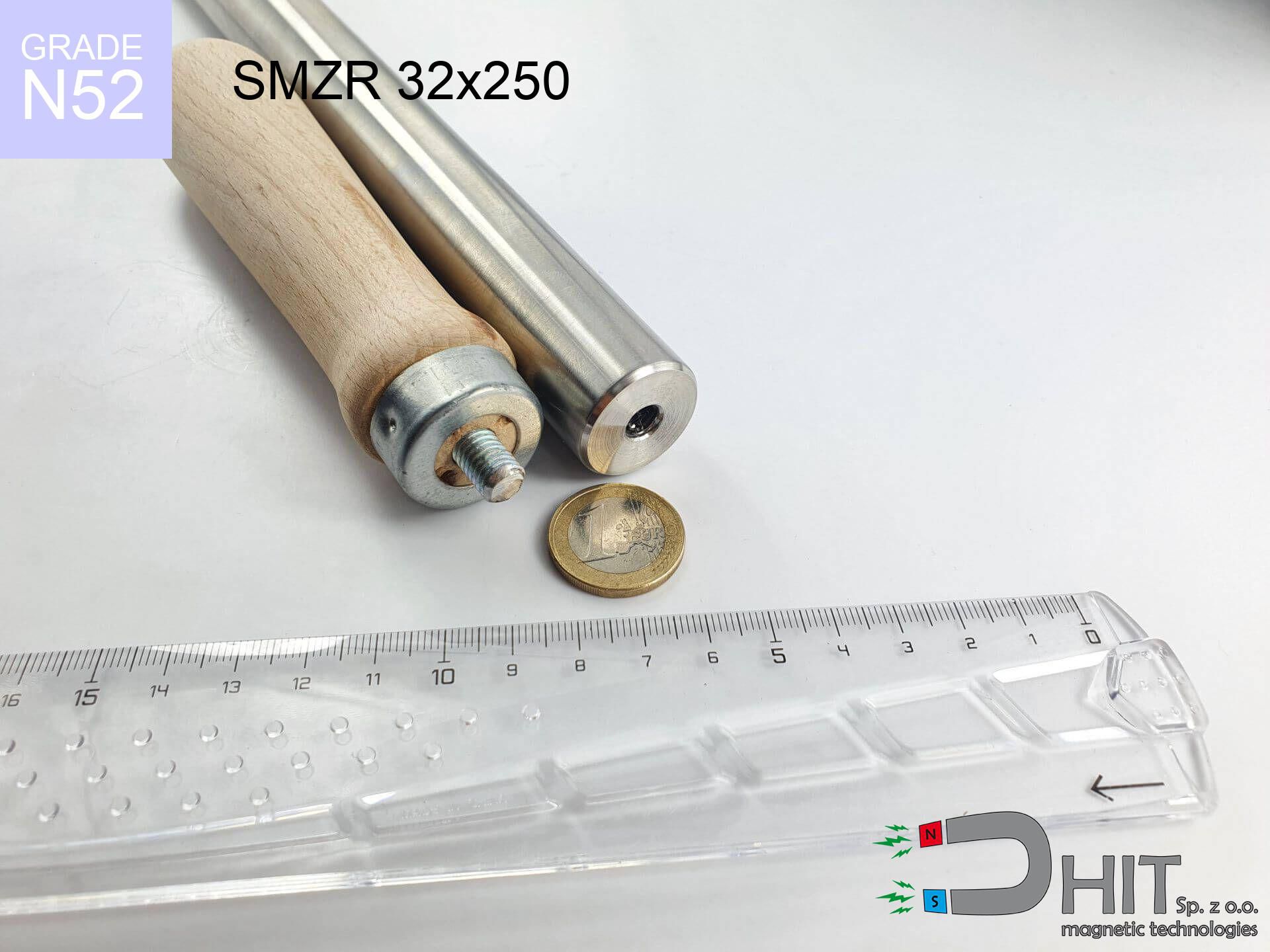SMZR 32x150 / N52 - magnetic roller
magnetic separator with handle
catalog number 140239
GTIN: 5906301813477
diameter Ø
32
mm [±0,1 mm]
height
150
mm [±0,1 mm]
max. temperature
≤ 80
°C
catalog number 140239
GTIN: 5906301813477
diameter Ø
32 mm [±0,1 mm]
height
150 mm [±0,1 mm]
max. temperature
≤ 80 °C
492.00 ZŁ gross price (including VAT) / pcs +
400.00 ZŁ net price + 23% VAT / pcs
bulk discounts:
need more quantity?Want a better price?
Give us a call tel: +48 888 99 98 98 or get in touch via contact form on our website. You can check the lifting capacity and the appearance of magnet in our force calculator magnetic mass calculator
Orders placed by 2:00 PM will be shipped on the same business day.
Specification: magnetic separator with handle 32x150 / N52
Magnetic properties of the material N52
Physical properties of sintered neodymium magnets Nd2Fe14B
Compilation of suggested goods
Advantages as well as disadvantages of neodymium magnets NdFeB.
In addition to immense strength, neodymium magnets have the following advantages:
- They do not lose their strength (of the magnet). After approximately 10 years, their power decreases by only ~1% (theoretically),
- They are highly resistant to demagnetization by external magnetic sources,
- Thanks to the shiny finish and nickel, gold, or silver coating, they have an aesthetic appearance,
- They have exceptionally high magnetic induction on the surface of the magnet,
- By using an appropriate combination of materials, they can achieve high thermal resistance, allowing them to operate at temperatures up to 230°C and above...
- The ability for precise shaping or customization to specific needs – neodymium magnets can be produced in many variants of shapes or sizes, which amplifies their universality in usage.
- Significant importance in the industry of new technologies – are used in computer drives, electric drive mechanisms, medical devices or other modern machines.
Disadvantages of neodymium magnets:
- They are prone to breaking as they are extremely fragile when subjected to a powerful impact. If the magnets are exposed to impacts, we recommend using magnets in a steel housing. The steel housing in the form of a holder protects the magnet from impacts and simultaneously increases its overall strength,
- Magnets lose their strength due to exposure to high temperatures. In most cases, when the temperature exceeds 80°C, these magnets experience permanent loss in strength (although it is worth noting that this is dependent on the shape and size of the magnet). To avoid this problem, we offer special magnets marked with the [AH] symbol, which exhibit high temperature resistance. They can operate even at temperatures as high as 230°C or more,
- Due to their susceptibility to corrosion in a humid environment, we recommend using waterproof magnets made of rubber, plastic, or other moisture-resistant materials when using them outdoors,
- The use of a cover or a magnetic holder is recommended due to the limited possibilities of manufacturing threads or complex shapes in the magnet
- Potential hazard to health from tiny fragments of magnets pose a threat, when accidentally ingested, which is crucial in the context of children's health. It's also worth noting that small elements of these devices can complicate diagnosis when they are in the body.
Precautions
Neodymium magnets can become demagnetized at high temperatures.
Under specific conditions, Neodymium magnets may experience demagnetization when subjected to high temperatures.
Neodymium magnets are over 10 times more powerful than ferrite magnets (the ones in speakers), and their strength can shock you.
To use magnets properly, it is best to familiarize yourself with our information beforehand. This will help you avoid significant harm to your body and the magnets themselves.
Magnets made of neodymium are especially delicate, resulting in shattering.
In the event of a collision between two neodymium magnets, it can result in them getting chipped. They are coated with a shiny nickel plating similar to steel, but they are not as hard. In the case of a collision between two magnets, there can be a scattering of small sharp metal fragments in different directions. Protecting your eyes is essential.
The magnet coating contains nickel, so be cautious if you have a nickel allergy.
Studies show a small percentage of people have allergies to certain metals, including nickel. An allergic reaction often manifests as skin redness and rash. If you have a nickel allergy, try wearing gloves or avoid direct contact with nickel-plated neodymium magnets.
Do not place neodymium magnets near a computer HDD, TV, and wallet.
Strong fields generated by neodymium magnets can damage magnetic storage media such as floppy disks, credit cards, magnetic ID cards, cassette tapes, video tapes, or other similar devices. In addition, they can damage televisions, VCRs, computer monitors, and CRT displays. You should especially avoid placing neodymium magnets near electronic devices.
Under no circumstances should neodymium magnets be brought close to GPS and smartphones.
Magnetic fields interfere with compasses and magnetometers used in navigation for air and sea transport, as well as internal compasses of smartphones and GPS devices.
Neodymium Magnets can attract to each other due to their immense internal force, causing the skin and other body parts to get pinched and resulting in significant injuries.
If have a finger between or alternatively on the path of attracting magnets, there may be a serious cut or a fracture.
Dust and powder from neodymium magnets are flammable.
Do not attempt to drill into neodymium magnets. Mechanical processing is also not recommended. If the magnet is crushed into fine powder or dust, it becomes highly flammable.
Keep neodymium magnets away from people with pacemakers.
In the case of neodymium magnets, there is a strong magnetic field. As a result, it interferes with the operation of a heart pacemaker. However, if the magnetic field does not affect the device, it can damage its components or deactivate the device when it is in a magnetic field.
Do not give neodymium magnets to youngest children.
Remember that neodymium magnets are not toys. Be cautious and make sure no child plays with them. In the case of swallowing multiple magnets simultaneously, they can attract to each other through the intestinal walls. In the worst case scenario, this can lead to death.
To raise awareness of why neodymium magnets are so dangerous, see the article titled How very dangerous are powerful neodymium magnets?.


![magnetic separator 32x500 [2xM8] / N42 magnetic separator 32x500 [2xM8] / N42](https://cdn3.dhit.pl/graphics/products/sm-32x500-2xm8-jan.jpg)
![magnetic separator 32x350 [2xM8] / N52 magnetic separator 32x350 [2xM8] / N52](https://cdn3.dhit.pl/graphics/products/sm-32x350-2xm8-fag.jpg)

![magnetic beam 950x180x70 [4x M8] magnetic beam 950x180x70 [4x M8]](https://cdn3.dhit.pl/graphics/products/bm-950x180x70-4x-m8-ves.jpg)

